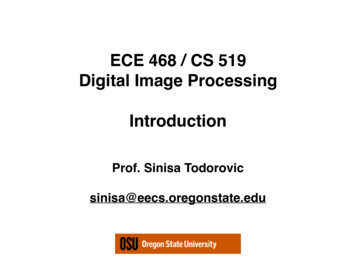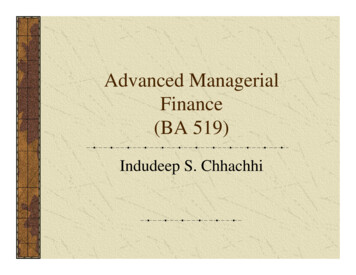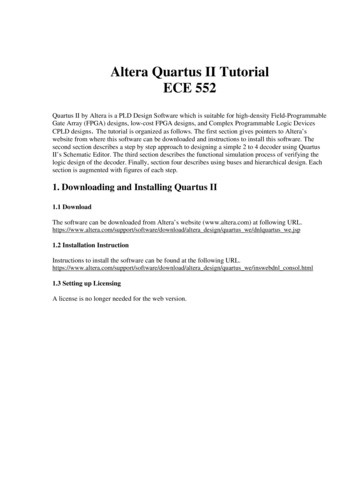
Transcription
ECE 468 / CS 519Digital Image ProcessingIntroductionProf. Sinisa Todorovicsinisa@eecs.oregonstate.edu
ECE 468: Digital Image Processing Instructor:Sinisa Todorovicsinisa@oregonstate.edu Office:2107 Kelley Engineering Center Office Hours:Tuesday 2:30-3PM, or by appointment Classes:MWF 2-2:50pm, BAT 144 Class website:http://web.engr.oregonstate.edu/ sinisa/courses/OSU/ECE468/ECE468.html
Recommended Textbook “Digital Image Processing” by R.C. Gonzalez and R.E. Woods,4th edition, Pearson Prentice Hall, 2018 Additional readings on the class website
Suggested Readings “Digital Image Processing Using MATLAB,” by R.C. Gonzalez,R.E. Woods, and S. Eddins, 2nd edition, Pearson PrenticeHall, 2009
Course Objectives Cover basic theory and algorithms widely used in image processing Develop hands-on experience in processing images Familiarize with MATLAB Image Processing Toolbox Develop critical thinking about the state of the art
Prerequisites Signals and systems: ECE 351 and ECE 352 Linear algebra Determinants, Systems of Linear EquationsEigenvalues, EigenvectorsStatistics and probability Matrices, Matrix OperationsProbability density function, Probability distributionMean, variance, co-variance, correlationPriors, Posteriors, LikelihoodsGaussian distributionGood programming skills
Requirements Homework Turn-in a hard copy Homework Mini-project must be implemented in MATLAB Homework should be an individual effort Late homework will not be accepted without prior approvalGraduate students will be given approximately 20% greateramount of work for homework assignments
RequirementsExams will be closed-book. Midterm on November 6, 2-2:50pm, BAT 144 Final on December 5, 12-1:30pm, BAT 144
Grading Policy Homework 20% Midterm Exam 35% Final Exam 45%
Academic Honesty -- Examples of Cheating Bringing forbidden material or devices to the examination Working on the exam before or after the official time allowed Requesting a re-grade of work altered after the initial grading Submitting a homework that is not your own work
A Typical Digital Image Processing Systeminputimageprocessedimagecamera3D worldalgorithmsrepresentationsproblem understandingtrade offstraining dataexpert systemsknowledge baseusers
What is a Digital Image?
Pixel ValuesSource: DIP/3e
What is a Digital Image?pixelxrowycolumn Two-dimensional function f(x,y) or matrix x, y, f(x,y) are discrete and finite Image size maxx x maxy -- e.g. 640x480 Pixel intensity value f(x,y) [0, 255]
Visible Spectrum of EM
Based on Psychophysical Studies Cones in the human eye red (R) 65% green (G) 33% blue (B) 2% R 700nm G 546.1nm B 435.8nm Color combination of primary colors R, G, B
Color Model Color System Color Space Purpose: To facilitate specification of colors RGB color model
Sources of Energy for Image FormationSource: DIP/3e
Some Applications -- Medical DiagnosticsGamma-ray imagingX-ray imagingSource: DIP/3e
Some Applications -- Magnetic Resonance Imaging
Some Applications -- MicroscopyVisible-light microscopy imagingSource: DIP/3e
Some Applications -- Industrial Inspection
Some Applications -- Remote SensingAerial imagesSatellite images
Some Applications -- Infrared Satellite ImagesSource: DIP/3e
Some Applications -- Storing ImagesStandardDVDBlue-rayDVD
Some Applications -- Transmitting ImagesVideo conferencing
Some Applications -- Image Forensics
Fundamental Steps in Digital Image Processing
Fundamental Steps in Digital Image Processing Acquisition Spatial and frequency transforms Enhancement (subjective) Restoration (objective) Color processing Multi-resolution processing Compression Morphological processing Segmentation
4th edition, Pearson Prentice Hall, 2018 . "Digital Image Processing Using MATLAB," by R.C. Gonzalez, R.E. Woods, and S. Eddins, 2nd edition, Pearson Prentice Hall, 2009. Course Objectives . Prerequisites Signals and systems: ECE 351 and ECE 352 Linear algebra










